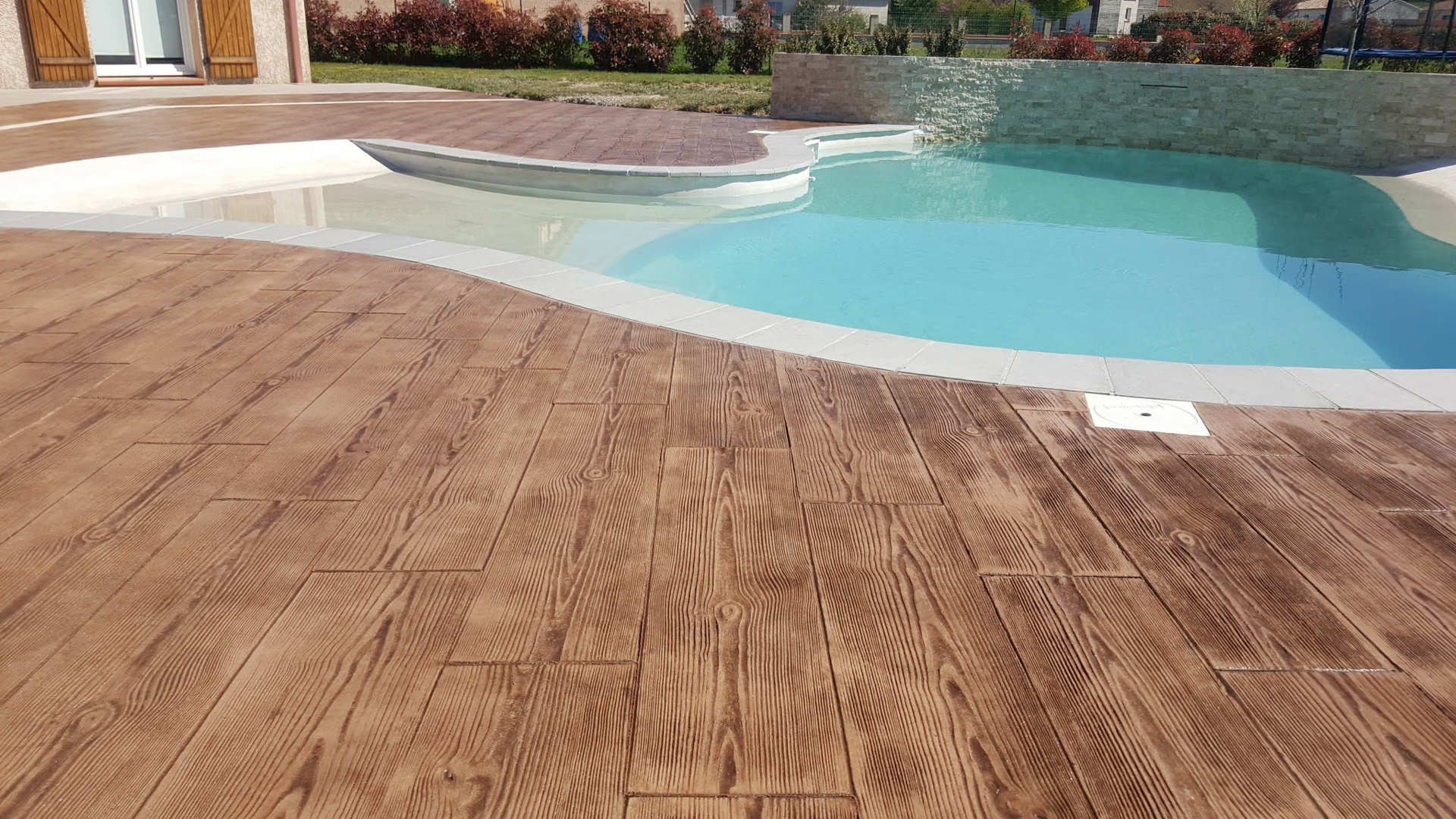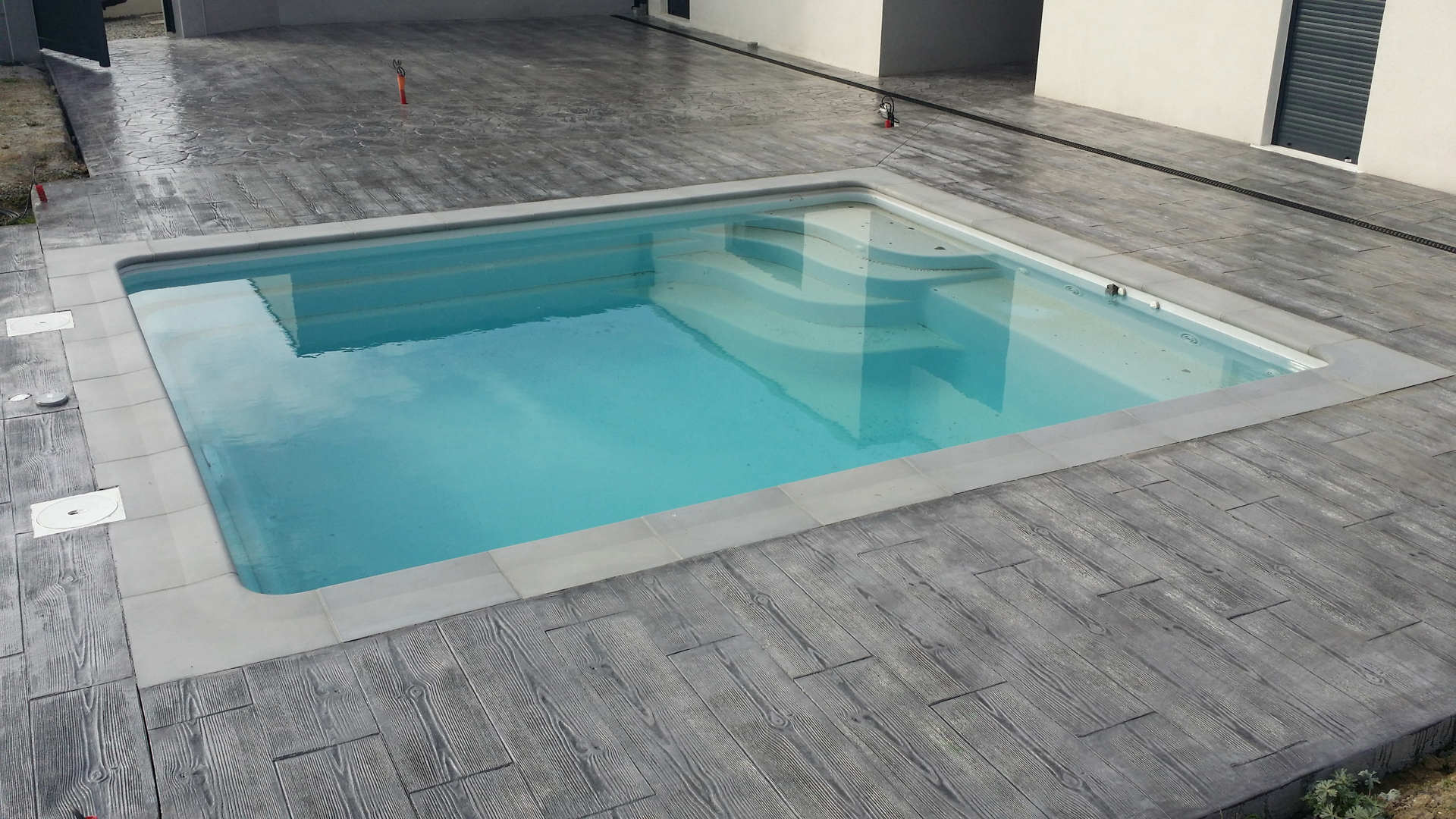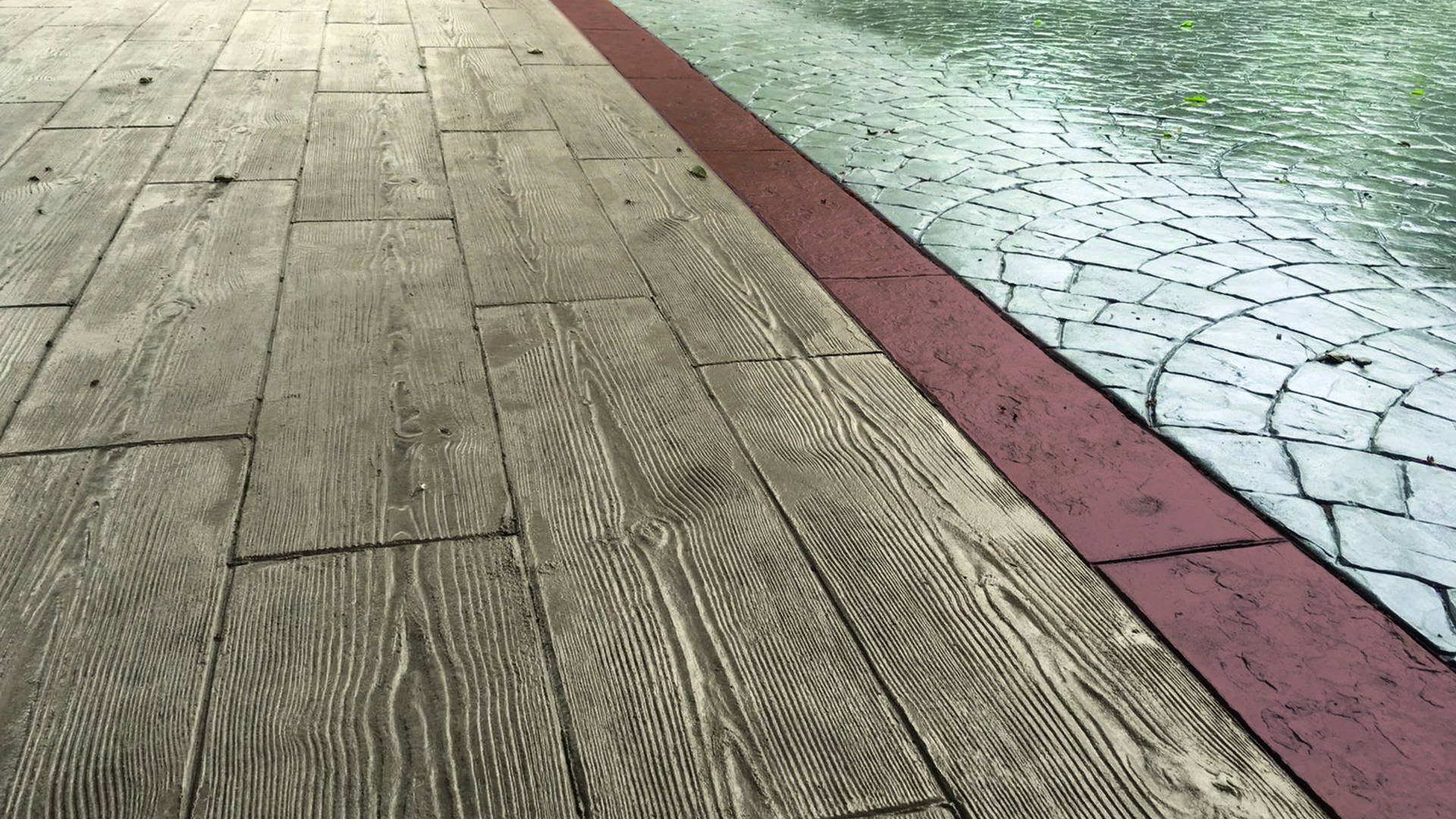Imprinted concrete imitation wood: everything you need to know
The common denominator of the construction and decoration sectors is innovation. The constant irruption of new materials that become a trend and that flood both the creation of spaces from scratch and the renovation of existing ones.
Despite this evidence, wood continues to be one of the most demanded and best valued among all the alternatives that the market offers. Thanks in part to the fact that it is an element that combines practically with everything and that it provides a feeling of warmth.
However, often due to lack of budget or incompatibility, one cannot always resort to wood when desired. Hence the importance of having other materials that aesthetically meet the same expectations. This is the case of theimprinted concrete ,one of the best alternatives to achieve the wood effect. A finish that, despite having been used for many years, its timelessness keeps it at the top.
In this article, we are going to give all the keys to the wood imitation imprinted concrete. We will explain what it consists of and how to execute it, its most notable advantages, the available colours as well as the price of it.
What is the wood imitation imprinted concrete?
The imitation wood imprinted concrete is a decorative finish that is obtained after carrying out a special process of stamping and texturing. A technique used mainly on pavements that is the result of applying a mould that imitates the appearance, texture and colour of the wood on the surface on which it is printed.
A decorative technique that replaces wood providing the same elegance and aesthetics as it, but more economical and executed in less time. In addition, imprinted concrete is much more durable and resistant, especially in damp areas where wood is not suitable.
The origin of wood imitation imprinted concrete is due to the need that builders had to replace wood with a material that offered the same finish without compromising the logging of trees. Beyond the perceptible purely ecological benefit, this decorative technique has ended up supplanting wood for many more reasons.

Why bet on imprinted concrete to imitate wood
Next, we develop the main reasons why the bet on imprinted concrete to emulate wood continues to increase. A material that causes a real sensation and that can also be placed on vertical surfaces.
1. Imprinted concrete is more affordable than wood
To renovate a space with wood, it is necessary to proceed with a reconstruction of the previously built surface. A restructuring that involves labour in addition to the cost of the material itself. A factor that does not occur with imprinted concrete, whose cost is reduced as it can be applied to any surface even if it is already built.
Likewise, the wood imitation imprinted concrete is more economical because it requires much less maintenance. And it should not be forgotten that wood is a noble material that needs to apply varnishes and other protectors frequently. If not done, the wear over time will become increasingly pronounced. A demand and constant care that influence the final price.
2. The wood imitation imprinted concrete is more eco-friendly
Although wood is one of the most beautiful materials, it also forms one of the most harmful to the environment. And it is undeniable the directly proportional relationship between deforestation and climate change. In this sense, the wood imitation imprinted concrete is much more ecological, as you only have to print a mould on the surface of still fresh concrete. It's all advantages.
3. Imprinted concrete is more resistant than wood
As previously mentioned, the need to apply varnishes every so often on wood is an indicator that its resistance is lower compared to imprinted concrete. And precisely the durability is one of the most notable benefits of imprinted concrete compared to other materials.
But not just for that. But also because wood is a more fragile material and is not recommended in some places, especially if they are exposed to a significant load of moisture. Wood does not withstand moisture and, consequently, it deteriorates and rots.
Wood is very sensitive, and therefore very easy to get damaged. Especially if it comes into contact with moisture, because it can end up lifting the support completely. This does not happen with wood imitation imprinted concrete, whose mould and varnish automatically give the surface a waterproof finish. Hence it can be applied, and in fact it is quite often, in outdoors. Spaces where the use of wood is not usually seen.
Termites are the great enemies of wood. On many occasions, no matter what is done to prevent their appearance, it is inevitable that they end up feeding on the cellulose present in the wood, completely weakening it. Meanwhile, the wood imitation imprinted concrete guarantees firmness and the ability to withstand large loads and unfavourable weather conditions.
Likewise, wood is more prone to scratches and knocks. On the other hand, imprinted concrete has good resistance to impacts and does not deteriorate from the sun's rays.
4. The maintenance of wood imitation imprinted concrete is less
Just as it happens with varnishes, the cleaning and maintenance of wood is more thorough and demanding. On the other hand, wood imitation imprinted concrete only needs a superficial cleaning with water. Although if desired, a detergent can be used.

Advantages of using wood imitation imprinted concrete
The imprinted concrete mimics all types of wood with a high degree of realism: pine, walnut, oak, maple, etc. In addition to the previously described benefits, it should also be added that this material prevents the growth of weeds or mould. Two elements that on many occasions can cause real headaches. A decorative technique that for these and many other reasons has displaced not only wood, but other materials.
A decorative as well as functional coating with which all types of environments can be seasoned. Among its most important advantages are:
The wood imitation imprinted concrete does not lose its shape or wear out over time.
It does not fade due to the effects of the sun or rain. Therefore, it is perfect for outdoor spaces.
Highly resistant to high traffic and impacts, as well as to humidity, the sun and other climatic factors.
Offers non-slip and waterproof finishes.
It can be applied on horizontal and vertical surfaces. Indoors and outdoors.
Long service life and virtually non-existent maintenance.
Quick installation and much cheaper than other materials.
Finishes of the most varied thanks to its extensive catalogue of moulds, designs and colours.
How to make wood imitation imprinted concrete? Step by step application
The application of wood imitation imprinted concrete is quite simple, although you always have to hire the services of an expert who guarantees a professional and optimal result. Below, we present the step by step to build an imprinted concrete surface that simulates the finish of wood.
Step 1: Choose the mould and surface.
Decide what type of wood you want to imitate with the imprinted concrete: pine, oak, etc. And where the chosen mould is going to be stamped: pavement, wall, indoors or outdoors.
Step 2: Delimit the surface.
Define the work area and prepare the surface before applying the concrete. Clean superficially and check that it is level. If not, proceed to level the ground. Compact and formwork.
Step 3: Spread and smooth the concrete.
Pour the concrete evenly over the pavement. We recommend the use of a mesh to reinforce the new coating. Then, smooth the surface with the help of a trowel or float.
Step 4: Float the concrete.
When the concrete is still fresh but has already begun to cure, trowel the surface.
Step 5: Colour the concrete.
Add the wearing course or imprinted mortar over the concrete, to give it colour. Sprinkle with the proportions indicated by the manufacturer. Trowel so that the product is properly introduced. Then smooth the pavement.
Step 6: Apply the release agent.
It can be in powder or liquid form. It prevents the concrete from getting embedded inside the imprinted mould. It can be used with the same colour, or different, to the colour hardener.
Step 7: Stamp the imprinted concrete moulds.
The moulds are what define the final finish and the shape that the surface will acquire. In this case, imitation wood imprinted concrete moulds. Step on the mould with your feet or with the help of a tamper.
Step 8: Cut concrete joints.
Use an electric cutter to ensure the lines are straight.
Step 9: Remove the release agent and clean.
Remove the release agent from the surface. About 72 hours later, wash the surface to remove residues that may have been impregnated.
Step 10: Protect the wood imitation imprinted concrete.
Apply the varnish or protective resin to ensure the durability of the finish. Check that the concrete is completely dry.

Wooden imprinted concrete pool: one of the most demanded pavements
The anti-slip properties, superior mechanical resistances, and the variability of aesthetic finishes, have led to imprinted concrete being one of the most suitable pavements for covering the area around the pool. Likewise, the little maintenance it requires and the elegance it brings to the space, are other factors that explain its success.
A decorative coating that represents a considerable economic saving, that withstands wonderfully to different weather conditions and offers a wide range of possibilities thanks to the moulds available for its stamping.
In this regard, one of the most used moulds of imprinted concrete for the pool, both for its aesthetics and the relief they provide, is the wood one. Infinite versatility, that's what a wooden imprinted concrete floor offers for the pool.
Moulds for imprinted concrete with wood effect
Para obtener un acabado que imite a la madera a la perfección hay que utilizar un molde específico de hormigón impreso. De hecho, para lograr una textura más natural y realista si cabe se pueden imprimir varios moldes para sacar diferentes dibujos en cada tarima. Un efecto propio de la madera natural.
Generally, the wood imitation imprinted concrete is used for the construction of floors and other horizontal surfaces. A most unique aesthetic that floods patios, terraces, houses, garages, pools, etc. A versatility that also extends to walls and facades to imprint a rustic atmosphere that never goes out of style.
At Topciment we have stamped concrete moulds specially designed to mimic the finish of natural wood. Moulds with exquisite adhesion, very comfortable to use and of extraordinary durability.
Colours imprinted concrete wood
The wood imitation imprinted concrete offers a wide variety of colours to decorate spaces. Depending on the environment to be renovated, one shade or another will combine better. It is not the same to renovate a terrace, for example, as a swimming pool or a shopping centre.
At Topciment we have four lines of pigmentsfor you to choose the one you like the most. Light and dark shades that capture the most demanded colours by users and that can be combined with each other to achieve a more original wood finish.
Wood imprinted concrete price
If this decorative finish has won you over with its endless possibilities and you are seriously considering its use, you should know that there is no predetermined cost. Although it is a fairly economical material compared to natural wood, there are several factors that can increase the cost of this type of imprinted concrete.
In general terms, the main factors affecting the price of imitation wood imprinted concrete are:
The price of labour stipulated by the construction company, as well as the machinery used for the renovation of the pavement or wall.
The amount of necessary material and the quality of the moulds also condition the price per square metre of this decorative technique. Also the varnishes with which the pavement or vertical wall is protected.
The geographical area plays a very important role in the price of wood imprinted concrete. In cities with a high degree of humidity, preliminary tasks must be carried out before the installation of this material, which increases its price compared to drier places.
The decorative finish that is sought conditions the price of imprinted concrete. Opting for a single decorative pattern is cheaper than combining colours, drawings and different textures. Everything depends on each particular project.
Generally, the cost does not vary much if the application of imprinted concrete is done on a horizontal or vertical support. However, a smaller surface is more economical. The square metres count to set the price, as does the thickness of the concrete slab.
In summary, all these factors need to be evaluated to determine one cost or another. But given the advantages of wood imprinted concrete, it is a more than recommendable material for paving all kinds of spaces. A finish that combines aesthetics and functionality.
In the case of Spain, for example, the price of wood imitation imprinted concrete is around 15-30 euros per square meter. But we must not forget that this is only an estimate, as the elements previously developed need to be analysed.
Subscribe to our newsletter
Receive in your email tips for the application and care of microcement, the latest trends and news from Topciment products.




